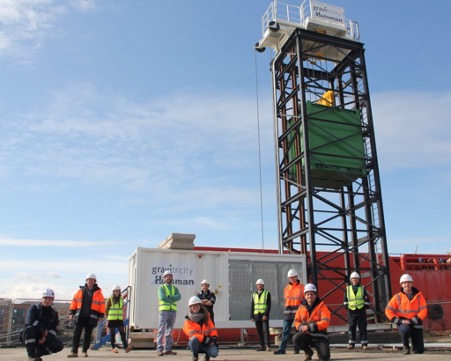Inertia-based power storage pioneers Gravitricity are positing steel-lined mine shafts and rock piercings nearly 400 metres deep as storage tanks for Britain’s soon-to-be-abundant hydrogen.
The Edinburgh-based proponents of big weights – pictured – falling to make instantaneous power have signed up a French construction firm to explore Britain’s re-purposed mine shafts and new drillings as solutions to the nation’s future storage needs for the gas.
Gravitricity posits re-purposed mine shafts as a “Goldilocks solution”, a middle way for high-volume storage neither as expensive as empty oil strata offshore, and neither as geologically sparse as onshore salt caves.
A new or re-conditioned shaft 365 metres deep and six in diameter could, when lined with steel, hold 100 tonnes of H2 at 220 bar, or so Gravitricity reason.
Watt’s mine, could be ores
By mid-century that could be the daily output of green H2, electrolysed from water with the output of a single 460MW offshore wind farm.
A thousand such shafts, branded as Flexistores, could accommodate around 25% of the 400,000 tonnes of H2, which by 2050 the government calculates should be powering Britain’s industrial processes and heating our buildings.
Eye-watering amounts of clean electricity from wind farms already goes to waste, – “constrained” in industry jargon – , for want of buffering or bunkering available in battery form, or through energy conversion. One industry estimate put the UK figure as high as 3.6 TWh in 2020, equating to one million homes’ power consumption for twelve months.
Now Gravitricity have signed a memo with VSL, the sub-surface engineering unit of French conglomerate Bouygues, to investigate technologies, geologies and locations, that could mine the potential of such shafts.
The partners are seeking funds to fit out a demonstrator ‘Flexistore’ installation somewhere beneath British soil, as a precursor to hundreds more.
How many holes in Blackburn, Lancashire?
Gravitricity recently completed a £300,000 feasibility study, conducted with Arup and funded by the UK Government’s BEIS HySupply programme. Their research proved the technical and commercial feasibility of storing large amounts of compressed hydrogen in a lined rock shaft.
“Green hydrogen will be vital, where electrification is just not feasible, or where industrial grey hydrogen is already used.”
“It is difficult to transport the gas. It therefore makes sense to locate hydrogen storage systems close to sources of renewable power – which can generate green hydrogen – and to potential users“, Blair said.
From VSL, its UK head Peter Hughes added “We are delighted to partner with Gravitricity to develop and deliver these pioneering ground engineering solutions for renewable energy generation and storage. This project is fully aligned with the VSL vision to focus our engineering capabilities and solutions on the global transition to a low carbon future.”




